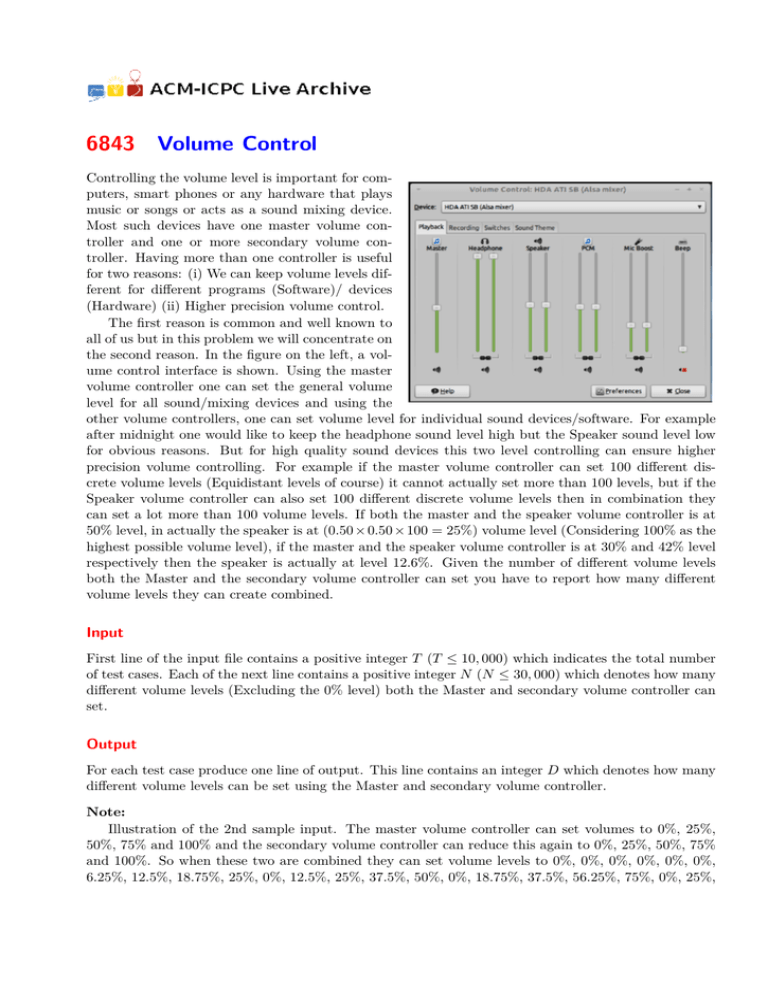6843 Volume Control - ACM
advertisement

6843 Volume Control Controlling the volume level is important for computers, smart phones or any hardware that plays music or songs or acts as a sound mixing device. Most such devices have one master volume controller and one or more secondary volume controller. Having more than one controller is useful for two reasons: (i) We can keep volume levels different for different programs (Software)/ devices (Hardware) (ii) Higher precision volume control. The first reason is common and well known to all of us but in this problem we will concentrate on the second reason. In the figure on the left, a volume control interface is shown. Using the master volume controller one can set the general volume level for all sound/mixing devices and using the other volume controllers, one can set volume level for individual sound devices/software. For example after midnight one would like to keep the headphone sound level high but the Speaker sound level low for obvious reasons. But for high quality sound devices this two level controlling can ensure higher precision volume controlling. For example if the master volume controller can set 100 different discrete volume levels (Equidistant levels of course) it cannot actually set more than 100 levels, but if the Speaker volume controller can also set 100 different discrete volume levels then in combination they can set a lot more than 100 volume levels. If both the master and the speaker volume controller is at 50% level, in actually the speaker is at (0.50 × 0.50 × 100 = 25%) volume level (Considering 100% as the highest possible volume level), if the master and the speaker volume controller is at 30% and 42% level respectively then the speaker is actually at level 12.6%. Given the number of different volume levels both the Master and the secondary volume controller can set you have to report how many different volume levels they can create combined. Input First line of the input file contains a positive integer T (T ≤ 10, 000) which indicates the total number of test cases. Each of the next line contains a positive integer N (N ≤ 30, 000) which denotes how many different volume levels (Excluding the 0% level) both the Master and secondary volume controller can set. Output For each test case produce one line of output. This line contains an integer D which denotes how many different volume levels can be set using the Master and secondary volume controller. Note: Illustration of the 2nd sample input. The master volume controller can set volumes to 0%, 25%, 50%, 75% and 100% and the secondary volume controller can reduce this again to 0%, 25%, 50%, 75% and 100%. So when these two are combined they can set volume levels to 0%, 0%, 0%, 0%, 0%, 0%, 6.25%, 12.5%, 18.75%, 25%, 0%, 12.5%, 25%, 37.5%, 50%, 0%, 18.75%, 37.5%, 56.25%, 75%, 0%, 25%, ACM-ICPC Live Archive: 6843 – Volume Control 2/2 50%, 75%, 100%. So unique volume levels these two can set are 0%, 6.25%, 12.5%, 18.75%, 25%, 37.5%, 50%, 56.25%, 75% and 100%, so total 10 different volume levels. Sample Input 2 3 4 Sample Output 7 10


